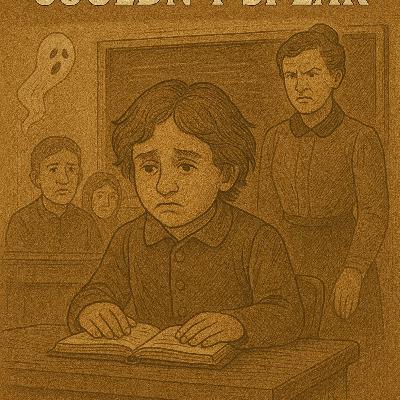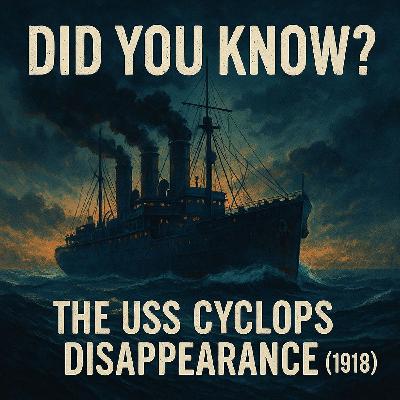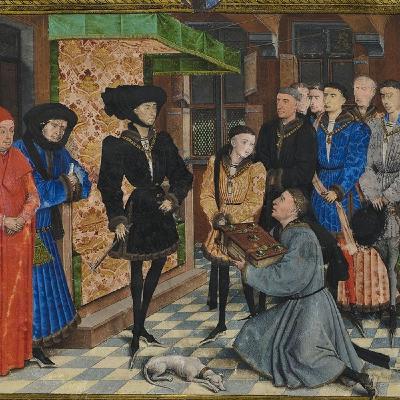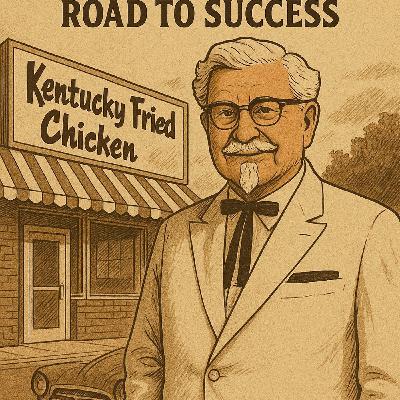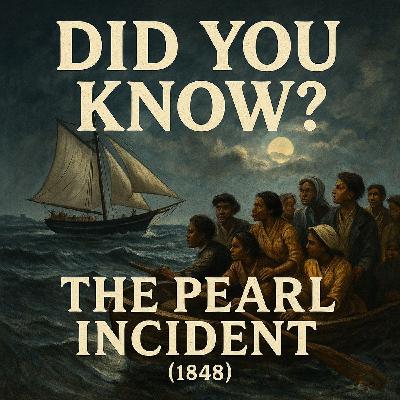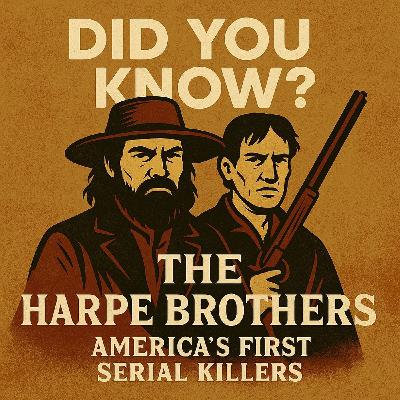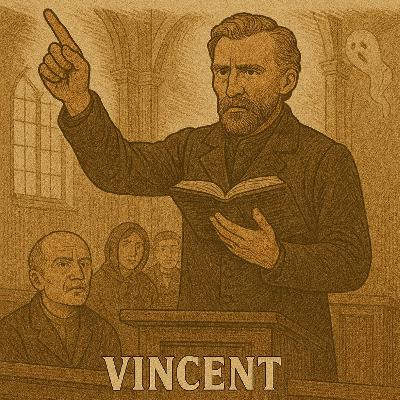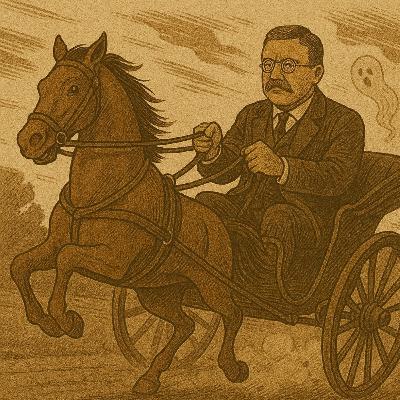Discover Did You Know?
Did You Know?

Did You Know?
Author: Eric Thompson
Subscribed: 0Played: 2Subscribe
Share
© Spreely Media
Description
Welcome to Did You Know?, the podcast that uncovers remarkable, lesser-known stories that challenge what we think we know.
DISCLAIMER: Some elements of this podcast may include AI-generated content, such as cover thumbnail images, show descriptions and some background audio.
Hosted on Acast. See acast.com/privacy for more information.
23 Episodes
Reverse
In the summer of 1518, the streets of Strasbourg filled with a haunting sight — hundreds of people dancing uncontrollably, some until they collapsed and even died. Known as The Dancing Plague, this bizarre event has baffled historians for centuries. Was it mass hysteria? Poisoned bread? Or a divine curse from Saint Vitus? In this episode, we uncover the strange story of history’s deadliest dance floor.See Privacy Policy at https://art19.com/privacy and California Privacy Notice at https://art19.com/privacy#do-not-sell-my-info.
In 897 AD, the Catholic Church staged one of the most grotesque trials in history — dragging the rotting corpse of Pope Formosus into court to stand trial. In this episode, we dive into the bizarre spectacle known as the Cadaver Synod, exploring the politics, paranoia, and power struggles that led to one of the darkest — and strangest — moments in papal history.See Privacy Policy at https://art19.com/privacy and California Privacy Notice at https://art19.com/privacy#do-not-sell-my-info.
In this episode, we unravel the shocking true story of America’s only known instance of a sitting congressman killing another in a duel. In 1838, as partisan tensions raged in Washington, Rep. William Graves of Kentucky fatally shot Rep. Jonathan Cilley of Maine on the dueling grounds of Bladensburg, Maryland. Discover how political rivalries, press scandals, and the 19th-century code of honor spiraled into tragedy—and how this fatal encounter changed Congress forever.See Privacy Policy at https://art19.com/privacy and California Privacy Notice at https://art19.com/privacy#do-not-sell-my-info.
In this episode, we uncover the fascinating true story of Adolf and Rudolf Dassler, two brothers who went from working together in their mother’s laundry room to founding rival global brands: Adidas and Puma. Their bitter feud not only split their hometown of Herzogenaurach, Germany, but also sparked a decades-long rivalry that shaped the modern sportswear industry. Discover how their personal conflicts, World War II tensions, and relentless competition turned a small-town shoe business into two of the world’s most iconic athletic brands—and left a legacy of innovation and rivalry that endures today.See Privacy Policy at https://art19.com/privacy and California Privacy Notice at https://art19.com/privacy#do-not-sell-my-info.
Did You Know? – Einstein: The Boy Who Couldn't Speak.Welcome to Did You Know — where history's forgotten truths come alive, and the smallest twists lead to the biggest turns. Today’s episode is about silence — and the extraordinary power hidden inside it. Imagine a boy, labeled as defective, incapable of learning, and unlikely to succeed. Now imagine that same boy growing into one of the most influential voices of the 20th century. This is the story of a child who couldn’t speak… until he changed the world.Born in 1879 in Ulm, Germany, young Albert Einstein didn't appear exceptional at first. In fact, he didn’t talk until he was nearly four years old. His parents worried something was terribly wrong. Some doctors suspected developmental issues. And when he finally began to speak, he would repeat sentences softly to himself — a strange habit known as echolalia, common in some forms of autism.School wasn’t much better. Albert struggled in structured classrooms, where memorization was prized over imagination. Teachers found him distant, distracted, even defiant. One is rumored to have told his father, “It doesn’t matter what he does, he’ll never amount to anything.”But what the world mistook as a limitation was, in fact, a unique way of thinking. Albert Einstein didn’t lack intelligence — he processed the world differently. While others recited facts, he explored ideas. He asked questions no one else dared to ask. He spent hours alone, contemplating the nature of light, time, and the universe.At the age of 16, he wrote his first scientific essay, questioning what it would be like to ride alongside a beam of light. This thought experiment would form the roots of his theory of relativity. But even then, academic institutions were skeptical. Einstein failed the entrance exam to a prestigious polytechnic school. When he finally graduated years later, he couldn’t find a teaching job. Instead, he became a clerk in a patent office.That’s right — one of history’s greatest minds spent years reviewing other people’s inventions while working quietly in obscurity. But in that quiet, his imagination soared. Between reviewing blueprints, he scribbled equations on scrap paper and built the foundations of modern physics.In 1905, a miracle year, he published four groundbreaking papers — one on the photoelectric effect (which would win him the Nobel Prize), one on Brownian motion, one on mass-energy equivalence (E = mc²), and one on special relativity. All this came not from a university lab, but from a desk in a patent office.Einstein didn’t fit the mold, and that’s precisely why he shattered it. He had once been the boy who couldn’t speak — now he was redefining reality itself.And beyond physics, Einstein became a moral voice. A refugee from Nazi Germany, he warned the world of fascism’s dangers. Later, he regretted his role in the atomic bomb’s theoretical basis and became a leading advocate for peace and disarmament. In his final years, he spoke not just of quarks and gravity, but of compassion, ethics, and unity. “Imagination,” he once said, “is more important than knowledge.”He also played the violin — often turning to music when he hit an intellectual roadblock. “The theory of relativity occurred to me by intuition,” he once explained, “and music is the driving force behind this intuition.” Einstein believed that creativity and logic weren’t opposites — they were partners. His mind danced between melodies and mathematics, physics and philosophy.He corresponded with some of the great thinkers of his time and challenged political powers. He was offered — and turned down — the presidency of Israel. When asked why, he humbly responded that he lacked the natural aptitude and experience for dealing with people. And yet, his words, both scientific and spiritual, inspired millions.Even his appearance — the wild hair, the simple clothes, the pipe — became iconic. But these quirks weren't for show. He lived simply, detested fame, and often declined public events. He remained, at heart, the quiet thinker who once puzzled over a beam of light.The child who once struggled to form a sentence ended up forming some of the most important thoughts of modern civilization. And his story reminds us that genius doesn’t always shout — sometimes, it whispers, patiently, waiting to be heard.So the next time someone seems out of step with the world, consider that they might be dancing to a deeper rhythm. The next time a child is slow to speak, maybe — just maybe — they’re getting ready to say something the world’s never heard before.Thanks for joining us on Did You Know — where the quietest stories often leave the loudest echoes. If you enjoyed this episode, please subscribe, leave a review, and share it with someone who needs to be reminded that being different can be a superpower. Hosted on Acast. See acast.com/privacy for more information.See Privacy Policy at https://art19.com/privacy and California Privacy Notice at https://art19.com/privacy#do-not-sell-my-info.
The USS Cyclops: The Navy’s Greatest Unsolved MysteryDid you know that the single largest loss of life in U.S. Navy history not caused by combat happened in 1918—and that it remains unsolved to this day?The USS Cyclops was a massive naval cargo ship, a collier, designed to carry coal and other heavy materials to support the growing power of the United States Navy. She was 542 feet long, 65 feet wide, and capable of carrying over 10,000 tons of cargo. Launched in 1910 and named after the one-eyed giants of Greek mythology, the ship served dutifully in the Atlantic, moving supplies from one port to another.But what happened in the early months of 1918 would make the Cyclops not only a historical footnote, but an enduring maritime mystery.In January of that year, the ship left Norfolk, Virginia, bound for Rio de Janeiro. She arrived without incident and spent the next several weeks loading a special wartime cargo: manganese ore, a dense, heavy mineral essential in steel production. With World War I raging in Europe, the U.S. needed as much manganese as it could get.After completing her mission in Brazil, the Cyclops left Rio in mid-February with 306 people aboard—sailors, officers, and civilian passengers—plus her full load of ore. She made a scheduled stop in the port of Salvador, then another unexpected one in Barbados. The ship’s captain, George Worley, reportedly claimed the ship was experiencing engine trouble. Yet, strange as it sounds, there was no official record of any repairs being made there.On March 4, 1918, the USS Cyclops departed Barbados, sailing north through the Caribbean Sea, bound for Baltimore. She was never seen again.No distress signals were sent. No wreckage was ever recovered. No bodies were found. One day, the ship simply vanished—into silence.In the wake of her disappearance, the U.S. Navy launched one of the largest search efforts in its history. Patrol boats, cruisers, and commercial ships scoured the sea. Coastal towns were contacted. Ports were checked. Yet no trace ever turned up. It was as if the Cyclops had simply ceased to exist.Theories began to swirl almost immediately. Was she sunk by a German U-boat? There were rumors of U-boat activity in the region, but Germany later denied involvement, and no U-boat ever claimed the sinking. Was there a structural failure? Some experts believe that the ship may have been overloaded—her cargo of manganese ore was heavier and denser than coal, and Cyclops had a history of engine trouble and hull stress. It’s possible that a sudden squall or rogue wave caused the already-burdened ship to capsize.Still others speculated about sabotage. Captain Worley was a peculiar figure. He was born Johann Frederick Wichmann in Germany and only later became a U.S. citizen. Some questioned his loyalty during wartime. Reports from crew members described him as erratic and even tyrannical, wearing civilian clothes instead of a naval uniform, and berating his men in front of passengers. Could there have been a mutiny? A sabotage from within?Perhaps the strangest element of the story is what happened years later: two of Cyclops’ sister ships, the USS Proteus and the USS Nereus—identical vessels also carrying heavy cargo—vanished under similar conditions during World War II, in nearly the same region of the Atlantic. These coincidences added fuel to growing whispers about the Bermuda Triangle.The Bermuda Triangle, that now-infamous stretch of ocean bounded by Miami, Bermuda, and Puerto Rico, had already seen numerous unexplained incidents. Planes vanishing from radar. Ships discovered adrift with no crew. Cyclops became a central legend in the growing lore of the Triangle—used by authors, conspiracy theorists, and even television specials as proof that something unnatural haunts that part of the ocean.Of course, the more rational explanation is simple: the North Atlantic, and especially the area around the Caribbean, can be incredibly volatile. Weather shifts quickly. Rogue waves occur. Ships without modern communications equipment were incredibly vulnerable to sudden storms, especially those that were older and overburdened.Still, the absence of any trace—no flotsam, no distress call, no log entries washed ashore—leaves even seasoned historians unsettled.To this day, the U.S. Navy lists the disappearance of the Cyclops as “cause unknown.” There are no definitive answers—only educated guesses.But what we do know is this: 306 souls boarded the Cyclops that March day in 1918. They never came home. Their families received no closure. And over 100 years later, they remain listed as lost at sea.So the next time you hear a story about the Bermuda Triangle, remember that for some, it isn’t just a mystery—it’s a memory. A story with names, families, and lives that simply disappeared.Thanks for listening to Did You Know?—where history’s forgotten moments are brought back to light. Hosted on Acast. See acast.com/privacy for more information.See Privacy Policy at https://art19.com/privacy and California Privacy Notice at https://art19.com/privacy#do-not-sell-my-info.
Before they made history with the world’s first powered flight, the Wright brothers were two industrious mechanics running a bicycle shop in Dayton, Ohio. Known as the Wright Cycle Exchange, their modest business opened in 1892 and evolved over time, giving the brothers valuable experience in mechanics, balance, and motion—skills crucial to aviation. It's hard to believe that the same minds that conquered the skies started out adjusting handlebars and selling inner tubes.As cycling surged in popularity in the late 1800s, the Wright brothers capitalized on the trend by repairing bikes and later manufacturing their own line of models. Their mechanical experiments with bicycles directly inspired key innovations in flight—most notably, the control systems used in their aircraft. Their bicycle workbench became a testbed for aerodynamic theories that would change the world forever. This often-overlooked chapter in their legacy reveals the humble and practical beginnings of two of America’s greatest inventors.The bicycle shop wasn’t just a source of income—it was a launchpad into the future of transportation. Long before they built wings, the Wright brothers were mastering wheels. Hosted on Acast. See acast.com/privacy for more information.See Privacy Policy at https://art19.com/privacy and California Privacy Notice at https://art19.com/privacy#do-not-sell-my-info.
Feeling nostalgic for a simpler time lately? You're not alone. Here’s one thing everybody who was alive during the 1970s can agree on: The entire decade still feels like it only happened yesterday.Really, how can the '70s be five decades in the past?It's just not possible that the era ruled by bell-bottom jeans and 8-track cassettes was half a century ago. For those of us who lived through it—and survived that groovy yet perilous time—it will forever be a part of our souls. Hosted on Acast. See acast.com/privacy for more information.See Privacy Policy at https://art19.com/privacy and California Privacy Notice at https://art19.com/privacy#do-not-sell-my-info.
Hollywood’s True Story Lies: 10 Films That Betrayed History This week on Did You Know, the spotlight turns to Hollywood's long-standing habit of rewriting history under the guise of “based on a true story.” While audiences expect some artistic license, a deeper dive into ten major films reveals just how far liberal-leaning Hollywood studios are willing to distort facts to serve their narratives.A number of high-profile films stray significantly from the truth—sometimes rewriting entire legacies in the process. The most glaring offender may be The Imitation Game, which misrepresented the personality and contributions of Alan Turing to fit a dramatic arc. What emerges from this review is not just a pattern of error but a clear agenda: modern filmmakers prioritize messaging over truth. Whether by glorifying certain groups, demonizing others, or crafting convenient fictional arcs, these distortions serve a broader cultural narrative often rooted in left-wing ideology. The erosion of factual integrity is not just an artistic misstep—it’s part of Hollywood's continued effort to reshape how Americans perceive their past. The Did You Know podcast this week emphasizes the problem of letting fiction pass as truth, especially when media giants continue to push historical revisionism under the pretense of entertainment.The lesson for listeners: don’t trust the silver screen to tell the truth. Do your own research and question the stories pushed by institutions that have consistently shown a willingness to bend reality to fit the message. Hosted on Acast. See acast.com/privacy for more information.See Privacy Policy at https://art19.com/privacy and California Privacy Notice at https://art19.com/privacy#do-not-sell-my-info.
The Pointy Truth About Medieval Shoes: Status Over Sanity During the 14th and 15th centuries, one of the most extreme fashion statements in medieval Europe came in the form of exaggeratedly long, pointed shoes known as poulaines. This peculiar footwear wasn’t just about style—it was about social status, excess, and elite vanity, which often came at the expense of practicality and even health. The longer the toe of the poulaine, the higher the wearer’s rank was perceived to be.This fashion trend, according to Ripley's Believe It or Not!, often led the nobility to wear shoes with tips extending up to 18 inches beyond the foot. These shoes were so impractical that some required tying the toes to the knees with chains just to walk. The My Modern Met article confirms that the length of these shoes became a visible symbol of wealth, clearly separating the upper class from the working class, who couldn't afford the extravagance or inconvenience. Critics of the trend at the time were not in short supply. Religious leaders and moralists condemned the shoes as symbols of vanity and excess. HistoryFacts.com reported that clergymen referred to them as “devil’s claws,” denouncing the elite's obsession with image over morality. Even the English crown took notice, leading to sumptuary laws limiting the length of shoe points. King Edward IV attempted to curb the excesses by banning overly long poulaines in 1463, particularly targeting those not of noble rank. This intervention reveals how much attention the fashion received—and how dangerous its cultural impact had become. From a conservative viewpoint, the rise and fall of poulaines serves as a historical reminder of what happens when vanity outweighs virtue. The excessive footwear wasn't about utility, function, or honor—it was about flaunting power and separating the elite from everyone else. This is a pattern that still repeats in today's culture of celebrity obsession and virtue-signaling fashion, where appearance often replaces substance. Modern culture frequently mocks traditional values while promoting absurdity in the name of “self-expression.” But the medieval obsession with impractical shoes shows that the abandonment of practicality and modesty in favor of elite signaling is nothing new. The parallels between then and now are too stark to ignore.When society exalts image above character, it leads not just to foolish styles—but to foolish priorities. The evidence from the articles confirms that these fashion statements caused physical deformities, public outrage, and eventually legal intervention. Yet, despite the obvious consequences, elites pushed forward with ever more ridiculous lengths. This historical trend serves as a timeless example of how society falters when appearances are prioritized over principles. It also speaks volumes about the moral confusion of leadership during the late Middle Ages, as church officials rightly criticized the absurd footwear but were largely ignored by a ruling class enamored with its own reflection.Ultimately, the story of the poulaine isn’t just a quirky footnote in history. It’s a cautionary tale. When leaders and influencers abandon restraint and embrace extravagance, the result is cultural decay masked as fashion. Pointy shoes in medieval Europe weren’t just about toes—they were about turning one’s back on common sense. Hosted on Acast. See acast.com/privacy for more information.See Privacy Policy at https://art19.com/privacy and California Privacy Notice at https://art19.com/privacy#do-not-sell-my-info.
Welcome to Did You Know?, the show that uncovers remarkable, lesser-known stories that challenge what we think we know. Today, we dive into the turbulent life of Vincent van Gogh — a man who, during his lifetime, was mostly ignored, mocked, and misunderstood, only to become one of history’s most revered artists.Van Gogh was born in the Netherlands in 1853. His early life was full of uncertainty and struggle. He failed at several careers before turning to art at 27 — late, by most standards. But what followed was a creative explosion. In just ten years, he produced more than 2,000 artworks, including nearly 900 paintings. That’s an average of one new piece every few days.Despite this incredible output, van Gogh sold only one painting while alive. His bold colors, rough brushstrokes, and emotional intensity baffled critics and buyers. He was dismissed as unstable. But van Gogh wasn’t simply a madman — he was a visionary. Hosted on Acast. See acast.com/privacy for more information.See Privacy Policy at https://art19.com/privacy and California Privacy Notice at https://art19.com/privacy#do-not-sell-my-info.
Today, we start with a household item that you've probably used dozens — maybe hundreds — of times without a second thought: a bar of soap. But not just any soap. This is the story of Ivory — the soap that floats — and how a simple accident turned into one of the greatest branding successes in American history.Let’s rewind to the 1870s. The Procter & Gamble Company, founded in Cincinnati by a candle maker and a soap maker, was doing steady business making candles and soap for the masses. One day in 1879, something unusual happened at the P&G factory. A worker — whose name has been lost to history — left the mixing machine running while he went on a break. He forgot to turn it off.When he came back, the soap mixture was filled with air. Rather than discard the batch, the company decided to mold and sell it anyway. What happened next was unexpected: customers started writing in to say they loved this new soap. Why? Because it floated.In an age before indoor plumbing was common, people often bathed in rivers, lakes, or shared tubs. If you dropped your soap, it sank. But this new soap didn’t — it floated. That made it easier to use and harder to lose.Realizing they had something special, P&G leaned in. They named the soap “Ivory” — a nod to its pure white color — and launched it with the slogan: “It Floats!” Later, they doubled down with an even bolder claim: “99 and 44/100% Pure.” That oddly specific figure came from laboratory testing and was meant to give the impression of scientific precision — a brilliant piece of marketing.The soap’s success was meteoric. Ivory became a household name and helped transform Procter & Gamble from a regional business into a national powerhouse. But it wasn’t just the soap that floated — it was the brand.P&G capitalized on the success by turning Ivory into more than just a bar of soap. It became a symbol of modern cleanliness, a staple in American bathrooms, and eventually a springboard for innovation. P&G used its earnings from Ivory to develop new products, fund research, and even build one of the first in-house advertising departments.Ivory soap also marked a major shift in how companies connected with consumers. P&G began producing radio programs — actual shows with stories and characters — that subtly promoted their products. These shows were the original soap operas — literally named because they were sponsored by soap companies.So, the next time you hear the term "soap opera," remember: it's a direct legacy of Ivory Soap and the creative marketing that surrounded it.But perhaps the most surprising part of the story is this: the floating quality that made Ivory so famous? It was a total accident. A mistake. A moment of human error that turned into a multi-million-dollar success.We often think of innovation as something that comes from genius or meticulous planning. But sometimes, it comes from a slip-up — from someone forgetting to turn off a machine. And what matters most is not the mistake itself, but how you respond to it.Procter & Gamble recognized an opportunity in the unexpected, and they ran with it. They embraced what made their product different. And in doing so, they didn’t just sell soap — they changed marketing history.Thanks for joining us on this first episode of Did You Know?. If you enjoyed the story, subscribe and share it with someone who loves a good behind-the-scenes surprise. And remember, sometimes the things that rise to the top — do so by accident. Hosted on Acast. See acast.com/privacy for more information.See Privacy Policy at https://art19.com/privacy and California Privacy Notice at https://art19.com/privacy#do-not-sell-my-info.
Welcome to our podcast as we dive deep into the overlooked twists and turns of history that changed the way we live, eat, move, and think.In this episode, we’re crunching into the crispy, salty origin of one of America’s favorite snacks — the potato chip. It’s the story of how one man’s frustration with a customer led to the birth of a billion-dollar industry.Let’s set the scene. The year is 1853. The place? Saratoga Springs, New York. A popular resort town, particularly among the wealthy elite who traveled there for its mineral springs, lush forests, and upscale hotels. One of those hotels, Moon’s Lake House, was known for its fine dining and scenic lake views. Hosted on Acast. See acast.com/privacy for more information.See Privacy Policy at https://art19.com/privacy and California Privacy Notice at https://art19.com/privacy#do-not-sell-my-info.
Did You Know? – About The Real Colonel Sanders' Road to Success?Welcome to our podcast where surprising truths from history are served up fresh in every episode. Today, we unwrap the real story behind one of the most iconic faces in fast food: Colonel Harland Sanders. You know the white suit, the string tie, the goatee. But did you know the Colonel didn’t find success until his 60s? His journey is one of grit, failure, reinvention — and ultimately, a bucket of success.Born in 1890 in Henryville, Indiana, Harland Sanders grew up fast. His father died when he was just five years old, leaving young Harland to care for his siblings while his mother worked. By the age of seven, he had learned to cook — not by choice, but by necessity. And this early start in the kitchen would stay with him for life.Sanders dropped out of school in the sixth grade. He worked an astonishing range of jobs over the years: farmhand, streetcar conductor, railroad fireman, insurance salesman, and even a steamboat pilot. He also studied law for a brief period and practiced it — until he got into a courtroom brawl with his own client. Needless to say, the legal profession didn’t last long.By the 1930s, Sanders had settled in Corbin, Kentucky. He was running a service station and began cooking meals for travelers out of the back room. He served hungry drivers fried chicken, ham, biscuits, and string beans. His cooking was so good that he eventually opened a full restaurant across the street — the now-famous Sanders Court & Café.In 1935, Kentucky Governor Ruby Laffoon gave Harland Sanders the honorary title of "Colonel" in recognition of his contributions to Kentucky cuisine. From that point forward, Harland embraced the role with showmanship — white suit, black string tie, goatee — creating the image that would eventually become globally recognized.But his big break still hadn’t come. Sanders spent the 1940s perfecting his fried chicken recipe. He used a pressure cooker to cut down the frying time while retaining flavor and moisture. His blend of 11 herbs and spices — a closely guarded secret to this day — became the centerpiece of his menu.However, tragedy struck in the 1950s. The construction of a new interstate highway diverted traffic away from his restaurant, which eventually forced him to sell it at a loss. Sanders, now in his 60s, had just his pressure cooker, a few spices, and a dream.That’s when he hit the road.With nothing but determination and a battered old car, Sanders began traveling the country, cooking his chicken in small restaurants and diners, offering them a deal: make his recipe, and he’d take a cut of the profits. Rejection followed him everywhere. Some estimate he heard the word "no" over a thousand times before someone said yes.But he kept at it. And finally, one restaurant owner agreed. Then another. Word spread. By 1964, Sanders had franchised over 600 locations. That same year, he sold the Kentucky Fried Chicken corporation for $2 million — a massive sum at the time — but he stayed on as the brand’s ambassador, appearing in ads and public appearances, always in character.It’s easy to forget that Sanders didn’t find real success until the latter part of his life. At an age when most people retire, he was just getting started. And while the corporate version of KFC grew into a global fast-food empire, Sanders never stopped caring about the quality of the food that bore his name.He remained a vocal critic of KFC’s corporate shortcuts and changes to his original recipe. In one now-infamous interview, he even called the gravy “wallpaper paste.” Despite his commercial image, Sanders was a real person — fiercely proud, stubborn, and passionate about good food.There’s a lot to take away from Colonel Sanders’ story. For one, age doesn’t have to define your peak. He reinvented himself not once, not twice, but many times over. His life was marked by hardship and hustle, with plenty of setbacks in between.And perhaps most importantly, Sanders turned personal failure into brand legacy. His image, his recipe, and his entrepreneurial persistence became something more than the sum of its parts. In a culture obsessed with overnight success, Sanders’ story reminds us that sometimes, the best things take time — and a lot of fried determination.So next time you see that smiling face on a red-and-white bucket, remember: it wasn’t just marketing. It was the story of a man who failed his way to global fame, and fried up the American Dream in the process.Thanks for listening to Did You Know? If you enjoyed today’s episode, subscribe and share with a friend who appreciates stories with unexpected twists. Until next time, stay curious — because every icon has a backstory.For more information on our podcast, visit our website: DidYouKnow.Life.Until next time, stay curious. Hosted on Acast. See acast.com/privacy for more information.See Privacy Policy at https://art19.com/privacy and California Privacy Notice at https://art19.com/privacy#do-not-sell-my-info.
In the spring of 1848, a small schooner quietly left the Washington, D.C. harbor with 77 enslaved people on board, marking the largest recorded nonviolent escape attempt from slavery in United States history?The plan was ambitious. The vessel was The Pearl, a modest two-masted sailing ship. Its goal was deceptively simple: sail from Washington, D.C., down the Potomac River, up the Chesapeake Bay, and ultimately reach freedom in the North. But behind that journey lay months of careful planning, brave conspirators, and an entire system designed to keep human beings in chains.The escape was coordinated by a biracial network of abolitionists. Among them were William L. Chaplin and Gerrit Smith, white allies from New York, and free Black residents of Washington like Paul Jennings and Daniel Bell. Bell was a formerly enslaved blacksmith whose wife and children were still enslaved. For him, this wasn’t a cause—it was personal.The captains hired to sail The Pearl were Daniel Drayton and Edward Sayres. Both white men, they had sympathies with the abolitionist cause. On the evening of April 15, 1848, they took aboard the 77 escapees, many of whom were women and children. They departed under the cover of night, hoping to reach the free state of New Jersey by way of the Atlantic coast.However, fate intervened. The wind shifted southward shortly after departure, forcing the schooner to anchor near Point Lookout, Maryland. There they waited helplessly while slave owners in Washington began to realize what had happened. A furious manhunt ensued. A steamboat, The Salem, was quickly dispatched by enraged slaveholders, and within two days, The Pearl was captured and all escapees were returned to Washington.The reaction was immediate and explosive. Washington’s pro-slavery faction erupted into riots. White mobs stormed through Black neighborhoods, destroying abolitionist property and threatening lives. One of the targets was the offices of the anti-slavery newspaper The National Era. Though few were killed, the violence demonstrated the fear and fury that slavery's defenders felt in the face of such bold resistance.Most of the 77 individuals were quickly sold to traders and shipped to the Deep South, ensuring they’d never again be near family or allies. Yet, amid the tragedy, a few stories emerged with remarkable endings. Among the escapees were Mary and Emily Edmonson, teenagers from a devout Baptist family. Their father, Paul Edmonson, worked tirelessly to buy their freedom. With the help of Henry Ward Beecher—brother of Uncle Tom’s Cabin author Harriet Beecher Stowe—Paul eventually raised the funds. The sisters were freed and went on to become prominent figures in the anti-slavery movement. They even attended college, rare for African American women of their time.Another lesser-known fact is that this failed escape directly impacted American politics. The incident caught national attention and became a focal point in the abolitionist press. It pressured Congress to address the intensifying conflict over slavery in the capital. Just two years later, as part of the Compromise of 1850, the slave trade was officially abolished in Washington, D.C. While slavery itself continued in the city until 1862, this legislative change was seen as a significant symbolic victory.Captain Drayton, though tried and convicted, used his imprisonment as a platform. He published a memoir from his jail cell, outlining the operation and exposing the inhumanity of slavery. His words added fuel to the abolitionist fire and shifted public opinion in the North.Though The Pearl never reached freedom, the story of its voyage resonated deeply across the nation. It revealed the extremes to which enslaved people would go for liberty—not just running individually through woods or by night, but coordinating a mass escape by sea. It also showed the extent to which abolitionists, Black and white alike, were willing to risk their lives and livelihoods in the fight for freedom.In recent years, The Pearl Incident has been revisited by historians, artists, and educators who see it not only as a failed escape, but as an act of bold resistance that helped change the trajectory of American history. In 1993, a play titled Pearl: A Play About the Largest Escape Attempt of Enslaved People in U.S. History debuted in D.C., bringing new attention to the forgotten heroes of that night. In 2022, a mural was painted in Southwest Washington to commemorate the event.Today, there's a quiet memorial in Southwest D.C., near the point of departure, marking the launch site of The Pearl. Tourists pass by it, unaware of the drama that once unfolded on those waters. But for those who know the story, it is a symbol of resistance, courage, and the relentless pursuit of justice.So the next time you walk along the Potomac or hear about ships and freedom, remember The Pearl. Hosted on Acast. See acast.com/privacy for more information.See Privacy Policy at https://art19.com/privacy and California Privacy Notice at https://art19.com/privacy#do-not-sell-my-info.
Did You Know? How The Exorcist Possessed American Culture?The horror film released in 1973 not only terrified moviegoers but also deeply influenced religion, cinema, and culture in America and beyond? That film was The Exorcist, and its legacy reaches far beyond the screen.The Exorcist was adapted from William Peter Blatty’s 1971 novel of the same name, which itself was inspired by the alleged real-life exorcism of a young boy in Maryland in 1949. Blatty, a devout Catholic, was fascinated by the implications of demonic possession in a modern, skeptical world. He teamed up with director William Friedkin, known for his gritty realism, to bring the story to life. What resulted was a film unlike anything audiences had seen before.The film follows Regan MacNeil, a 12-year-old girl who becomes possessed by a mysterious and increasingly violent entity. As her behavior spirals out of control—levitating, speaking in tongues, and contorting her body—her desperate mother seeks help from two priests: Father Merrin, a seasoned exorcist, and Father Karras, a Jesuit struggling with his faith. Together, they confront not just a demonic force, but their own personal demons.From the moment it premiered on December 26, 1973, The Exorcist sent shockwaves through popular culture. People fainted during screenings. Some vomited. Others fled theaters mid-scene. Reports emerged of theatergoers suffering panic attacks, heart palpitations, even miscarriages. In Washington D.C., ambulances were called to the theater. In Los Angeles, a man sued the filmmakers, claiming the film made him pass out and injure himself.The film earned over $440 million worldwide—a staggering figure for the time—and became the highest-grossing R-rated movie ever until it was overtaken decades later. But it wasn’t just the box office success that made it legendary. The Exorcist became a cultural litmus test for how Americans viewed fear, evil, and the role of faith in a modern age.In the early 1970s, America was in the midst of cultural turmoil: the Vietnam War, Watergate, the sexual revolution, and growing distrust in institutions. The Exorcist landed like a bombshell, confronting audiences with the terrifying idea that evil wasn’t just metaphorical—it was real, personal, and could inhabit your child. For many, this deeply resonated.Religious reactions were mixed. Some clergy praised the film for showing the power of faith and the Catholic Church’s role in combating evil. Others condemned it as blasphemous, grotesque, and dangerous. The Vatican didn’t officially endorse the film, but many Catholic leaders noted that it sparked renewed interest in spiritual warfare and exorcism rites. Following the film’s release, reports of possession and calls for exorcisms spiked around the world. The Catholic Church, once hesitant to discuss exorcism publicly, began reexamining its guidelines and training new exorcists in greater numbers.The influence of The Exorcist on filmmaking was profound. It legitimized horror as a serious cinematic genre. Before its release, horror was largely dismissed as pulp entertainment. Afterward, it became a space for complex storytelling, moral questions, and mainstream prestige. The film’s groundbreaking use of practical effects—like the 360-degree head spin, levitations, and the pea soup vomit scene—set a new standard for realism in supernatural films.It also sparked an entire wave of exorcism- and possession-themed films, from The Omen to The Amityville Horror, Poltergeist, and beyond. It influenced directors like John Carpenter, Wes Craven, and even modern filmmakers like Ari Aster and James Wan. You can see its DNA in nearly every horror movie involving demons or spiritual warfare.But the film also left its mark in subtler ways. The idea of demonic possession entered pop culture in a way it never had before. People referenced “going full Exorcist” when discussing extreme behavior. Halloween costumes of Regan became widespread. The creepy piano score, the eerie whispers, the cold breath in the exorcism scene—all became iconic.The Exorcist was re-released in theaters in 2000 with additional footage, including the infamous “spider walk” scene. Once again, it performed well, drawing both nostalgic fans and curious new viewers. In 2010, the Library of Congress selected the film for preservation in the National Film Registry, cementing its status as a cultural treasure.Nearly fifty years after its release, The Exorcist still provokes, disturbs, and captivates. It asks unsettling questions: What if evil isn’t just a social construct? What if belief matters more than we think? And what do we lose when we cast faith aside?So the next time you think horror is all cheap thrills and jump scares, remember The Exorcist. A film that terrified a generation, rekindled religious debates, and redefined what a scary movie could be.Thanks for listening to Did You Know?. Hosted on Acast. See acast.com/privacy for more information.See Privacy Policy at https://art19.com/privacy and California Privacy Notice at https://art19.com/privacy#do-not-sell-my-info.
Did You Know that America’s first known serial killers weren’t operating in the shadows of a modern city, but on the wild frontiers of the 18th century? Meet Micajah and Wiley Harpe—two men so brutal, even their fellow outlaws were terrified of them. Known as Big Harpe and Little Harpe, these two left a trail of death and fear across Kentucky and Tennessee during the early years of the United States.The Harpes were born in the 1760s, likely in North Carolina, to Scottish immigrant families. Though they were cousins, they often referred to each other as brothers. During the American Revolutionary War, they fought not for the colonists, but for the British, aligning themselves with Loyalist raiders known as the Tories. It was during this time that they reportedly participated in looting, pillaging, and violence against patriot families.When the war ended in 1783, the Harpes didn’t give up their violent ways—they simply redirected them. Rather than return to a peaceful life, they took to the lawless American frontier, where early settlements had little or no formal law enforcement. For men like the Harpes, this was the perfect environment to indulge their bloodlust.They joined up with a gang of river pirates along the Mississippi, robbing flatboats and murdering travelers. By the 1790s, the Harpes had become infamous along the frontier, not just for their criminal activities, but for their astonishing cruelty. Unlike most outlaws who killed for money or revenge, the Harpes seemed to kill purely for the thrill.They traveled with three women—two of whom were reportedly kidnapped—and a growing group of children. It’s said that Big Harpe murdered his own infant child for crying too loudly, slamming the baby against a tree. This horrifying act shocked even fellow criminals and sparked widespread revulsion.Their known murder spree began in earnest around 1797, spanning Tennessee and Kentucky. They posed as weary travelers or preachers, gaining the trust of strangers. Then, without warning, they’d slaughter their victims, often mutilating the bodies afterward. Throats were slashed, limbs severed, and torsos split open. Big Harpe had a signature method of execution—he would gut his victims and fill the body cavity with stones, then sink them into rivers to conceal the evidence.In one especially heinous incident, they killed a man named Johnson, whose corpse was found disemboweled and stuffed with rocks. Another victim, a young boy, was butchered for no apparent reason while out in the woods. These were not crimes of passion or self-defense—they were calculated, cold-blooded murders.What set the Harpes apart from other violent men of their era was the randomness of their killing. They murdered travelers, innkeepers, farmers, and even children. Sometimes they stole from their victims, but just as often they left valuables behind, suggesting the motive wasn’t robbery—it was bloodlust.As the death toll climbed, the public outcry reached a boiling point. Posses were formed to track the brothers down. In 1799, their rampage came to an end when a group led by Moses Stegall—whose wife and child had just been murdered by the Harpes—caught up with them near Henderson, Kentucky. Big Harpe was shot, captured, and reportedly confessed to over twenty murders before dying. His final request was for water, which Stegall denied. Harpe’s decapitated head was later mounted on a tree as a warning to others. That site became known as Harpe’s Head Road—a grim reminder of his legacy.Little Harpe managed to escape, blending in with the very criminal underworld that had once feared him. Years later, he joined the infamous river pirate Samuel Mason, but his luck ran out. He was eventually captured, identified, and executed in 1804. Like his cousin, his head was also displayed publicly.Despite the horror of their crimes, the Harpe Brothers are rarely mentioned in mainstream historical accounts. Part of the reason may be the frontier setting—isolated, sparsely documented, and long mythologized. But these early American murderers left an impression that lingers in regional folklore to this day.Their story exposes the thin line between civilization and chaos on the early American frontier. In a world without police, jails, or even newspapers in many towns, violence could thrive unchecked. The Harpes remind us that the old frontier was not just a place of rugged pioneers and noble settlers—it was also a haven for predators.And yet, their crimes spurred action. Communities began organizing more formal law enforcement, and tales of the Harpes became cautionary legends. Parents would warn children about “Harpe country,” and travelers took up arms just to cross the territories they once haunted.The Harpe Brothers weren’t just America’s first serial killers—they were symbols of a violent, ungoverned age that the country struggled to move beyond.Thanks for listening to Did You Know?. Hosted on Acast. See acast.com/privacy for more information.See Privacy Policy at https://art19.com/privacy and California Privacy Notice at https://art19.com/privacy#do-not-sell-my-info.
Did You Know? - About The Haunted House Built by Guilt?Welcome to our podcast that dives into the strange, the surprising, and the often-overlooked stories that reshape the way we see the world. Today’s tale is one of wealth, grief, and ghostly obsession. We’re talking about the mysterious Winchester Mystery House — a sprawling, maze-like mansion in California, built not from blueprints, but from fear... and perhaps, guilt.To understand the house, we must first understand the woman behind it: Sarah Winchester. Born in 1839, Sarah was the wife of William Wirt Winchester, heir to the massive Winchester Repeating Arms fortune — the company that manufactured the "gun that won the West." These rifles weren’t just popular; they were revolutionary. But they were also deadly. By the late 1800s, the Winchester rifle had taken countless lives, both in war and in expansion across the American frontier.When William died of tuberculosis in 1881, Sarah inherited a staggering $20 million — that’s over half a billion dollars today — and a daily income from Winchester stock. But with the money came something else: grief... and possibly guilt.Sarah had lost not only her husband but her infant daughter Annie years earlier. Alone and inconsolable, she sought guidance from a spiritual medium in Boston. The story goes that the medium told her she was cursed. The spirits of those killed by Winchester rifles were haunting her family. The only way to appease them? Move west and build. Build a house... and never stop building.And that’s exactly what she did.In 1884, Sarah Winchester moved to San Jose, California and purchased an unfinished farmhouse. Over the next 38 years — until her death in 1922 — she directed a constant stream of construction. The house ballooned into a seven-story, 160-room labyrinth filled with architectural oddities: staircases that lead to ceilings, doors that open into walls, and windows built into floors.Why? Some believe she was trying to confuse the spirits. Others think she was driven by grief, channeling her sorrow into an endless, architectural distraction. But what’s undeniable is the care and consistency with which she approached the project. Carpenters were hired around the clock, working in shifts, ensuring the building never stopped — just as the medium had advised.The result? A Victorian marvel shrouded in superstition. The Winchester Mystery House features 10,000 windows, 2,000 doors, 47 stairways, and dozens of secret passageways. Some parts of the house were constructed and then sealed off for reasons no one fully understands. And despite its vast size, there was only one working bathroom — another way, perhaps, to confuse restless spirits.Sarah herself was reclusive, rarely seen and never photographed after moving to California. She wore a black mourning dress every day and conducted her life in near silence. Each night, it’s said, she would retreat to a different bedroom, never sleeping in the same one twice — again, a defense against vengeful ghosts.Skeptics argue that Sarah was merely eccentric, possibly suffering from an undiagnosed mental illness compounded by trauma and isolation. But many who’ve visited the mansion swear it’s haunted. Tour guides and visitors alike have reported strange sounds, ghostly figures, and sudden cold spots. Some even claim to have seen Sarah herself wandering the halls.The story doesn’t end with her death. When Sarah passed away in 1922, construction stopped... immediately. The house was sold and turned into a tourist attraction within months. Over the decades, it became a legend — a Gothic puzzle box symbolizing not just ghost stories, but deeper questions: Can guilt be built into walls? Can a house become a confession?Whether you believe in spirits or not, the Winchester Mystery House stands as a haunting reminder of the cost of violence — and the weight of legacy. Sarah Winchester didn’t need to keep building. She chose to. Her life became a slow-motion act of penance, one nail at a time.In a world where wealth often insulates people from consequences, Sarah's story flips the script. She inherited blood money — and instead of ignoring it, she built a monument to it. Not to glorify, but to somehow make peace with it. It’s not a story about ghosts. It’s a story about conscience.So next time you hear the term “haunted house,” remember: sometimes, the real ghost isn’t a figure in the hallway... it’s the truth we can’t escape.Thanks for listening to Did You Know? If this episode gave you chills or made you think twice about what a home can hold, be sure to subscribe and share. Until next time, stay curious — because every legend begins with a whisper of truth.For more information on our podcast, visit our website: DidYouKnow.Life.Until next time, stay curious. Hosted on Acast. See acast.com/privacy for more information.See Privacy Policy at https://art19.com/privacy and California Privacy Notice at https://art19.com/privacy#do-not-sell-my-info.
Did You Know? – About The Artist Who Wanted to Preach.Welcome to Did You Know? — the podcast that dives deep into the lesser-known corners of history, shedding new light on the people and events you thought you knew. Today, we uncover the surprising spiritual journey of one of the most famous names in art. You’ve likely seen his bold brush strokes and swirling skies, but you may not know that before he painted, he preached. This is the story of Vincent van Gogh — the artist who wanted to save souls long before he ever captured beauty on canvas.Vincent van Gogh’s name is now synonymous with tortured genius. His vivid paintings, emotional honesty, and tragic death have become part of global cultural memory. But if we step back in time to his early life, we find a very different Vincent — one filled with spiritual longing, deep compassion, and a desperate desire to serve a higher purpose.Born in 1853 in the Netherlands, Vincent grew up in a religious family. His father was a Protestant minister, and young Vincent felt an early pull toward faith and service. In his early twenties, he pursued work as a lay preacher and missionary, eventually enrolling in theology studies. But the traditional academic route didn’t suit him. He struggled with formal education, often clashing with instructors and failing exams. Still, his conviction didn’t waver.Eventually, he found a position as a missionary in the coal-mining region of Borinage, Belgium — a place marked by poverty, grime, and hardship. There, Vincent embraced the community, giving away his possessions and living like the miners he ministered to. He slept on floors, wore tattered clothes, and dedicated himself to helping the sick and the poor. But his radical empathy, ironically, alarmed his superiors in the church. They dismissed him for taking his mission too literally, too intensely. And just like that, Vincent’s dream of preaching was crushed.This crisis shattered him. He returned home, emotionally broken, with no sense of purpose. And then, something extraordinary happened: he picked up a pencil. He began to sketch the world around him — first in quiet, humble tones. Miners, farmers, peasants — the same people he once tried to preach to — became his subjects. Through art, he found a new voice.Van Gogh came to believe that painting could reach the soul in ways words could not. In a letter to his brother Theo, he wrote, "I want to touch people with my art. I want them to say: he feels deeply, he feels tenderly." His mission hadn’t changed — only the medium had. The paintbrush became his pulpit.Over the next decade, Vincent poured himself into art. He studied obsessively, experimented, and evolved. His palette exploded with color after moving to the south of France. His brushwork became more expressive. But beneath the brilliance, he struggled with mental illness, isolation, and rejection. He sold only one painting in his lifetime.Yet the desire to connect — to inspire — never left him. Works like The Potato Eaters, Sunflowers, and Starry Night weren’t just experiments in form. They were expressions of faith, suffering, beauty, and humanity. In a way, each painting was a sermon.Even in his letters, Vincent revealed a mind forever wrestling with purpose and meaning. He often quoted scripture and wrestled with existential questions, writing to Theo, "What am I in the eyes of most people — a nonentity, an eccentric, or an unpleasant person? Somebody who has no position in society and will never have. In short, the lowest of the low. All right, then — even if that were absolutely true, then I should one day like to show by my work what such an outcast has in his heart."His life was a paradox — a man who failed to preach by word but succeeded through color, who battled darkness while illuminating the lives of others. He once said, "There is nothing more truly artistic than to love people." That single belief drove both his failed ministry and his triumphant artistry.Vincent van Gogh died in 1890 at the age of 37, having never seen the impact his art would have. But today, he is remembered not just for his genius, but for his heart — a heart that once longed to preach from the pulpit, and instead preached with paint.So the next time you gaze at a van Gogh painting, don’t just admire the color or technique. Listen for the message beneath the strokes — the voice of a man who wanted to save souls, and in his own way, may have done just that.Thanks for joining us on Did You Know? If this episode gave you a new perspective, please subscribe, leave a review, and share it with someone who loves a good twist in history. Until next time, keep your eyes open — and your heart, too.For more information on our podcast, visit our website: DidYouKnow.Life.Until next time, stay curious. Hosted on Acast. See acast.com/privacy for more information.See Privacy Policy at https://art19.com/privacy and California Privacy Notice at https://art19.com/privacy#do-not-sell-my-info.
Did You Know? – The President Who Loved SpeedWelcome to Did You Know? — the podcast that digs up the hidden, quirky, and often surprising backstories that change the way we see the people and events we thought we knew. Today, we take a wild ride — quite literally — with a man you probably remember from your history books. He wasn’t just a war hero or a world leader. He was also... a speed demon. Buckle up, because this is the story of Theodore Roosevelt — the president who loved speed.When we think of American presidents, we often imagine solemn men behind desks, signing bills or delivering stirring speeches. But Theodore Roosevelt? He broke the mold. Born in 1858 into a wealthy New York family, he was a sickly child with asthma. But instead of letting illness define him, he made a vow to live a life of action. He boxed, he hiked, he hunted. And he never stopped moving. Literally.Roosevelt’s love for movement translated into a deep obsession with speed. As an adult, he embraced modern transportation with gusto. Whether it was riding horses through rough terrain, speeding in early automobiles, or chasing down criminals on horseback when he was New York City’s police commissioner — Roosevelt wanted to go fast. And when he became President of the United States in 1901, after the assassination of William McKinley, he didn’t slow down.In fact, Roosevelt was the first U.S. president to ride in an automobile while in office. This wasn’t just a novelty for him — it was a thrill. He loved driving at high speeds on rough roads, often to the horror of his Secret Service detail. There are stories of Roosevelt taking the wheel himself — flying through the countryside without regard for the early rules of the road. To Roosevelt, life was too short to take the scenic route.And cars weren’t enough. Roosevelt was also the first president to fly — not while he was in office, but shortly afterward. In 1910, he took a ride in a Wright Brothers biplane at the age of 51. Think about that. Just seven years after the Wrights first got off the ground, Roosevelt climbed into an open-cockpit airplane and soared above Missouri. No helmet. No parachute. Just guts and goggles.But Roosevelt’s obsession with speed wasn’t just about technology. It was a reflection of his entire philosophy on life. His famous motto — “Speak softly and carry a big stick” — wasn’t just about foreign policy. It was about living boldly, decisively, and with force. He believed that progress required energy, motion, and a willingness to take risks.And he lived that philosophy right up to the edge. During a 1912 campaign speech — after his presidency — Roosevelt was shot in the chest by an assassin. And what did he do? He coughed into his hand, saw no blood, and decided the bullet hadn’t hit a lung. Then he gave a 90-minute speech... with a bullet still lodged in his ribs. That’s not just speed — that’s steel.Even his approach to conservation — something he’s widely celebrated for — was tied to this need for movement. He created national parks and forests not just to preserve beauty, but because he believed Americans needed space to roam, ride, hike, and explore. He once said, "A man who has never been in the wilderness cannot know the world.” To Roosevelt, the natural world was a racetrack for the soul.He was, in every way, a man in motion. Whether charging up San Juan Hill with the Rough Riders during the Spanish-American War, or charging ahead with political reforms, Roosevelt never idled. He governed the way he lived — boldly, rapidly, and without brakes.So next time you think of presidents as cautious or calculated, remember Theodore Roosevelt — the man who raced through history at full throttle. He didn’t just lead a nation; he chased destiny with his foot on the gas.Thanks for listening to Did You Know? If today’s episode made your heart race a little faster, be sure to subscribe, leave a review, and share it with someone who loves history with a twist. Until next time, keep your mind open — and your engine running.For more information on our podcast, visit our website: DidYouKnow.Life.Until next time, stay curious. Hosted on Acast. See acast.com/privacy for more information.See Privacy Policy at https://art19.com/privacy and California Privacy Notice at https://art19.com/privacy#do-not-sell-my-info.



